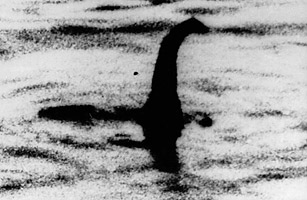
Reports of a large, long-necked serpent loping around the waterways of the Scottish highlands date back as far as the 7th century A.D. The monster of Loch Ness — a dark shape that resembles a brontosaurus — has been seen crossing country roads and peering out from wooded glens, but its most famed habitat is the deep freshwater lake in northern Scotland that spawned its name. In 1934, a Scottish doctor claimed he saw a monster in Loch Ness. He grabbed his camera and snapped what became known as the "surgeon's photograph," one of the iconic photos of the 20th century. In the decades since, dozens of scientists have conducted sonar scans and plunged inside submersibles into the lake's depths, sometimes picking up tantalizing, albeit inconclusive, readings of a mysterious, unusually sized object. A 2003 study commissioned by the BBC employed satellite tracking and took sonar readings from around 600 different locations in the lake. The search yielded nothing; however, "Nessie" will likely continue to capture imaginations, ensuring that the legend of this monster at least will never die.